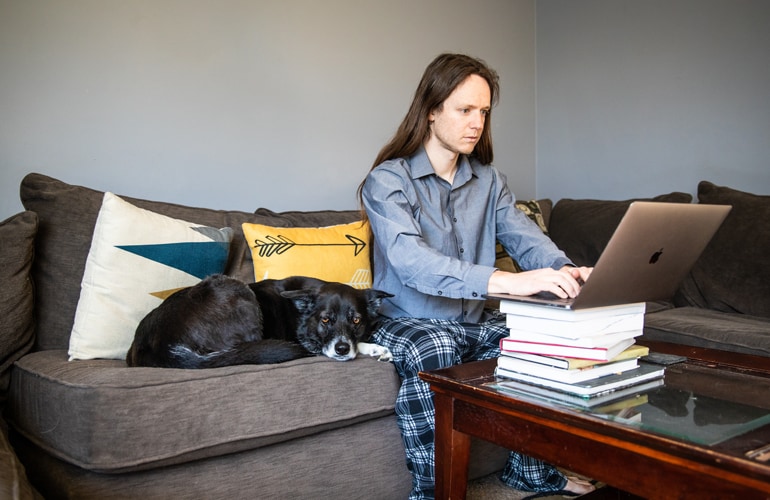Welcome to the mobile workforce! As millions of people around the country and world have shifted to working from home — the Bureau of Labor Statistics doesn’t have current numbers on that specifically, but has estimated nearly 30 percent of the U.S. population could work remotely in some capacity — there’s been a plethora of advice on how to work from home, from getting a comfy chair to whether it’s possible to be productive in pajamas.
And if you’re anything like us, you might be finding some things work while others just don’t.
Being in the connection business, we decided to pick up our mobile and call, email and text a range of professionals around the country doing a range of jobs, who are experts in the art of working from home — because it’s already been part of their work routine.
Following you’ll find advice for employee and employer alike, from all sides, to make the most of working from home.
Set Yourself Up for Success Every Day
Regan Wood, a professional photographer in New York whose work has appeared in publications such as the New York Times, begins her day with a healthy mix of self care and programmed determination. “I meditate every morning before I start working to get into a different mindset,” she says. “I have an action plan (to-do list) that I make each day using the Wunderlist productivity app. I love the little ding it makes every time I check something off.”
She also uses her smartphone to have a virtual daily standup to make sure she’s keeping herself on task and honest: “I have another freelance friend, and we talk every morning to turn over our actions for the day, hold ourselves accountable for the actions of the day before and get support around any actions that we find challenging.”
Dress for Success, If Not to Impress
Whitney Pastorek, who manages music artists in Nashville, has been working strictly from home for the past decade. On the subject of “Do I need to wear pants?” — which seems to come up often! — she says yes. But allows room for interpretation.
“Yes, you must change out of your pajamas,” she says. “Put on something to go to work in.”
But it doesn’t have to be office formal, or even necessarily office casual.
“My uniform for the last decade has been yoga pants or running tights, sports bra, t-shirt and layers over that when it’s chilly,” she says. “The added bonus here is the ability to incorporate exercise into my day without having to change clothes.”
Keep Your Spirits Up by Helping to Lift Others’
Bridget Ritchie, vice president of global development for an international moving company, has worked from her Chicago-area home full-time for just over 11 years and says that incorporating a little outward kindness into her day has helped her learn to be “a much more positive and fulfilled person, and that has really helped my whole at-home work experience.”
She advises doing something thoughtful for someone else each week, if not every day. “This may sound odd, but when you work from home, you can both get lonely and, unfortunately, also fall off of other people’s radars. So, change that. They will appreciate and remember you for it.”
She suggests sending a little gift or flowers when appropriate, making a call to someone who hasn’t heard your voice in a while, or even something as simple as a hand-written card or note as a thank you, or just to say hello or offer a compliment.
“That goes a long way in today’s electronic world,” she says. “I send out handwritten cards to all of my teams after we have global meetings. They love it and have even taken pictures of them and publicly thanked me on LinkedIn or Facebook because they’re so appreciative that I took the time.” Or even just send an email or direct message to someone you haven’t spoken to in a long time — and who will be pleasantly surprised by it.
Figure Out What Works for You — It Might Take Some Time
Amber Naslund, a 20-plus year marketing professional and current senior content consultant at LinkedIn, started working from home exclusively in 2008 and hasn’t turned back since. Her biggest tip to share? She says it isn’t really a tip at all.
“No two people work the same way, so it’s OK if it feels messy and imperfect at first,” she says. “It probably took me a full six months to find a groove — from the schedule that worked best to the office setup and tools that were most helpful. There was a fair bit of experimentation involved before I felt like I had it nailed. I still say a good chair and good headphones are essential tools that I absolutely couldn’t do without. I also love having a whiteboard in my office for brainstorming and notes.”
But there was a lesson in there too: “The hardest — and most important — lesson for me was about boundaries. When your home also becomes your office, it’s far too easy for ‘all time’ to feel like ‘work time’ (that’s why having a separate space for work is super important). Making sure you have consensus among your team about what hours are ‘official’ hours is critical. I had to be careful not to let too much work slip into evenings and weekends all the time. When you’re remote, you can feel like you have to be instantly accessible. I even turned off notifications on my email and IM clients on my phone so that I don’t feel like a constant slave to them when I’m not on work time. Communication and setting expectations with your teams and leadership is important to make that work, but if everyone has healthy boundaries about work, the entire remote experience is more effective and productive.”
Move Like It Matters (Because It Does)
Gita McCutcheon, who owns a PR and marketing agency in New York and is always juggling a roster of many high-profile and demanding clients, decided to take the work-from-home plunge about five years ago — to actually get more work done.
“I decided to forfeit my office for working remotely, since most of the work we do is at a computer or by phone and our in-person meetings (either with my team or with clients) were infrequent,” she says. “Having an office space didn't really make sense anymore. I already probably worked more than half of my time from home anyway so that I could have dedicated and uninterrupted time to do the work I needed to get done.”
Her top tip? “Exercise is a big part of how I think working from home works best — it’s both mentally and physically beneficial. I find that working out before starting work is really good so that I get my blood flowing and break a sweat, so that by the time I dive into work, I’m not just staying in the same spot all day. I also set a timer for every hour (when I don't need to block time completely without distraction) to remind me to move — either I will walk to fill up water, or I will do a few crunches or mat exercises. Being sedentary for too long is dangerous so I try to stay mindful of moving. I even have a moveable desk for my laptop — it’s small, on wheels and it can convert to a standing desk so I can move around my apartment — it’s genius and doesn't take up a lot of space. I had an office and also worked from various parts of my apartment, but this has been the best desk-slash-workspace decision.”
Be Dependable
Bonnie Smith — the owner of Studio B Entertainment, a diversity-driven Chicago-based brand experience agency that specializes in producing consumer, influencer and retail customer experiences for women — jumped from agency office life to work-from-home life when she first started her business six years ago.
“As an owner with employees, my recommendation for employees is to make sure you’re producing and keeping your manager regularly informed,” she says. “Having a positive presence, whether it be in person or virtually is important. Employers put a lot of trust in their employees to work and manage their time effectively and efficiently. Also, be prepared and on time for calls.”
She also advocates for small moment of self care, and uses her mobile device to easily do so: “I use the Insight Timer app. Even if you only have five minutes, it works. It helps me start my day in a positive mood, which in turn helps me produce better work and increased productivity.”
Create Staff Routines That Mimic Office Life
Jake Goldman — founder and president of digital agency 10up, whose clients include many large Silicon Valley companies (and, full disclosure, T-Mobile) — is something of a legend in the work-from-home world. Having been a consultant in the digital and media spaces since the late ’90s, he’s been working from home in some form for over 20 years. When he started his own company almost a decade ago, he decided that was going to be the way he and his entire staff would work all the time.
“I was inspired by companies like Automattic and 37signals (now Basecamp) who were fierce advocates, and we’ve been fully work from home since our first full-time hire, back in August 2011. We now have a staff of around 200 full-time, working from home (or in some cases, co-working spaces) around the globe.”
For Goldman, creating a virtual office culture was imperative: “Many of the routines you associate with going to an office are healthy habits for productive work, even if you're staying at home — especially for those making a transition from office work. Most people's minds compartmentalize and most humans are truly creatures of habit — if you’re lying in bed your in pajamas, you’re literally not in the right ‘head space’ to focus on work.”
Here are three tips he offers for creating a killer virtual office culture:
- Insist on ‘cameras on’ when video conferencing. “Visual cues are a huge part of good communication, particularly in group settings or meetings, and more naturally creates empathy. At 10up, we insist on ‘cameras on’ — if your camera isn't on, we expect a reason (eating lunch, traveling to a meeting, etc).”
- Coach a culture of focus. “When your meetings and creative sessions are literally in front of your screens, and that’s the place where most communication happens, it’s easy to fall into multitasking or tending to other work and not really pay attention to the conversation at hand — it’s like looking at your phone throughout a meeting. Politely or jovially call people out when they’re clearly distracted or not listening, and encourage people to turn on do-not-disturb modes. If you have to multitask — just as you might in an office — let your colleagues know, i.e. ‘I have to get this urgent email out — forgive me while I multitask for the next few minutes.’”
- Use a company chat platform that promotes expression and supports social channels. “I’ve found that most companies (even those that don’t have a work from home policy) have tools like Slack or Microsoft Teams already. If you don’t, make that investment. If you do, and you’re new to work-from-home culture, I’d encourage supporting the creation of organic social channels — parenting groups, Star Wars fans, dog lovers, you name it — so people can get a dose of company culture and personality that they might normally find in the office. I also recommend supporting integrations like Giphy (animated gif look ups) and a rich library of emojis that employees can contribute that can ‘lighten the mood’ in those rooms and inject a bit more personality into routine conversation.”





